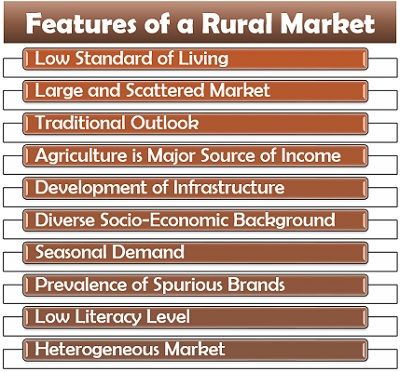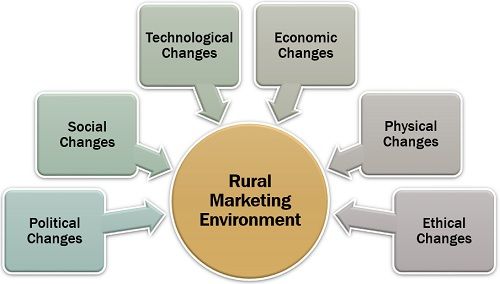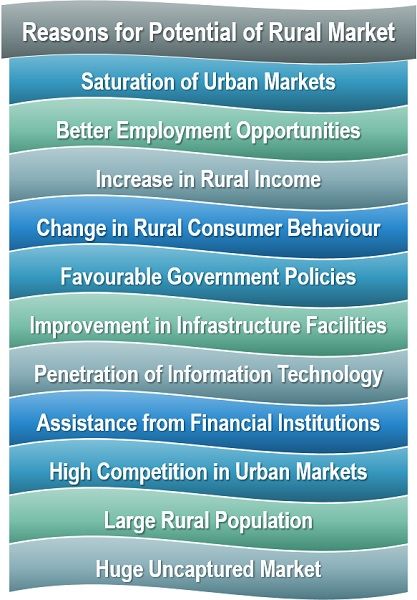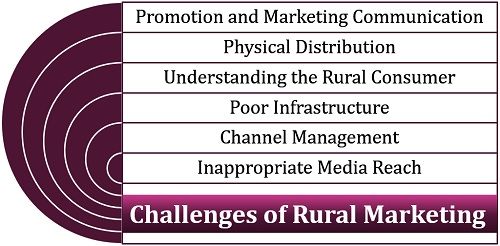Definition: Rural marketing refers to the framing and application of various marketing principles and strategies along with the marketing mix by the companies to capture the potential market and satisfy the needs of the people living in the remote areas of the country.
Example: One of the prominent marketing strategy adopted was Nokia’s launch of affordable mobile phones ‘Nokia 1100’, which has a bright torch and an alarm clock. This was done to facilitate the rural population residing in the areas where there is no electricity.
Content: Rural Marketing
Ways of Rural Marketing
The rural marketing involves two primary elements; one is rural and second is urban. The exchange of goods between these two markets can be understood in the following ways:
- Urban to Rural: The products manufactured in cities such as the FMCG products, fertilizers, consumer durables, etc. are made available in the remote areas. This is termed as urban to rural marketing.
- Rural to Urban: The goods manufactured or grown in rural areas or villages, including crops and other agricultural products, handicraft items, pottery products, etc. are sold to the consumers of urban areas. It is known as rural to urban marketing.
- Rural to Rural: When a rural manufacturer sells products like cattle, pottery, carts, etc. to other villages, it is called as rural to rural marketing.
Features of a Rural Market
What do we understand by a rural market? What differentiates it from an urban market?
The rural market can be understood as the selling and distribution or exchange of goods in the village or remote areas. The following characteristics will help us to understand the rural market better:
Low Standard of Living: The village lifestyle is quite conservative and straightforward. People here spend more on necessities instead of luxury goods, making it very different from that of city life.
Large and Scattered Market: A significant percentage of the population resides in villages. There are numerous villages located throughout the country, with a small group of people living in each of them. Thus, the rural market is spread over a vast area.
Traditional Outlook: The village population tend to stick to their traditions and are resistant to change due to low literacy level. However, the rural youth is initiating development though at a slower pace.
Agriculture is Major Source of Income: The village population is highly dependant upon the agricultural income for their living. In the case of crop failure, the rural people have low disposable income.
Development of Infrastructure: The rural areas lack proper infrastructure facilities such as appropriate transportation, cemented roads, communication network, banks, warehouses, etc.
Diverse Socio-Economic Background: Since the fertility of the land is uncertain and covers a large geographical rural area, there is a social-economic diversity in the people of these areas.
Seasonal Demand: The seasons and stages of agriculture, influence the demand for goods and services in rural markets. Hence they have two major seasons, namely kharif and ragi.
Prevalence of Spurious Brands: In rural areas, people are more price-conscious and illiterate. Due to this, several fake brands penetrate these markets with cheap products that look similar to the original ones.
Low Literacy Level: The percentage of illiteracy is quite high in remote areas. Thus, disconnecting them with the print media and therefore, the marketers use another medium such as radio, roadshows and nukkad dramas for rural marketing.
Heterogeneous Market: The people living in the villages belong to different religion, culture, social and economic backgrounds, linguistics, etc. and therefore have disparate perspective and demands.
Rural Marketing Environment
All markets exist in an external environment where the business organizations function. The following are the environmental factors which influence the trade practices in rural marketing:
Political Changes
The government’s intervention in the trade and commerce practices promoting the small scale rural industries and penetration of other business units in the rural areas to enhance the condition of people living in these areas, influence the rural markets to a great extent.
Social Changes
The social environment consists of the following:
- sociological factors, i.e., rural consumer’s lifestyle, preference and habits;
- anthropological factors determine the culture and the way of living of the consumer and;
- psychological factors constitute of the attitude, perception, behaviour, personality and mental soundness of the consumer.
All these factors also influence the rural markets.
Technological Changes
With technological advancement, marketers make use of the latest marketing tools and strategies. Also, the modes of communication and transportation have been improvized to produce the goods or services available to rural consumers in a short period.
Economic Changes
The marketers need to consider economic factors, including a healthy competition, consumer welfare and optimal price to conquer the rural markets.
Physical Changes
Another essential factor is the physical distribution of the goods or services into the rural markets, which can be achieved through the development of infrastructure.
Ethical Changes
Business ethics are essential for achieving the long-term goals of the organization. Thus, the moral values of the company play a key role in marketing the products in rural areas.
Reasons for Potential of Rural Market
Why would a business invest resources in the rural market? How does it benefit the organizations?
Let us now understand the various opportunities that a rural market holds for business organizations and companies:
Saturation of Urban Markets: The metropolitan areas are well-equipped with different products and services. Therefore, the companies rescue to the rural markets to increase sales.
Better Employment Opportunities: The government is engaged in developing job prospects other than agricultural activities for the rural population through Jawahar Rozgar Yojana (JRY). It provides an opportunity for the companies for entering the rural markets.
Increase in Rural Income: As modern agricultural practices have emerged in rural areas, the farmers have been able to produce a better harvest and reduce crop failures. This has ultimately increased the disposable income of the villagers.
Change in Rural Consumer Behaviour: The demand for goods or services in rural areas is immensely pricing sensitive. However, consumers are moving towards the purchase of technical products, like mobiles and computers. Thus, expanding the growth scope for the companies.
Favourable Government Policies: The government carry out varied programmes and frames various policies to develop job opportunities and promote the sale of goods and services in rural markets.
Improvement in Infrastructure Facilities: The infrastructure growth, i.e., construction of roads and warehouses, transportation services, developing communication network, etc. in the remote areas, is another benefit for the companies investing in these areas.
Penetration of Information Technology: The rural population is slowly upgrading to technology and using new modes of communication and media like mobile phones, television, etc. Thus, creating enormous opportunities for business organizations.
Assistance from Financial Institutions: The banks and other financial institutions encourage the rural population for purchasing more goods by facilitating the loans and advances at an attractive rate of interests.
High Competition in Urban Markets: In urban areas, the people have complete knowledge about the goods or services and are highly brand conscious. However, rural markets are still in need of better products or services.
Large Rural Population: The significant advantage of entering the rural markets is that the company gets exposure to a large population with many potential consumers.
Huge Uncaptured Market: There is vast scope for the companies to introduce new products in the remote areas of the country to build up their market.
Challenges of Rural Marketing
Rural markets are complex and extremely different from the regular or urban markets. Therefore, it is quite challenging for a business to penetrate the rural market and survive in the long run.
To know more about the various threats of this market, read below:
- Promotion and Marketing Communication: The companies need to re-structure the promotion and marketing strategies for the goods or services for the rural markets keeping in mind their multiple features.
- Physical Distribution: Due to the improper infrastructure, many villages lack connectivity and transportation, which ultimately acts as a hurdle in the allocation of goods or services to the consumers of these areas.
- Understanding the Rural Consumer: The rural consumers are quite conservative, traditional and cultural, which is reflected even in their demand for goods or services. Therefore, it is difficult to understand their preference and taste.
- Poor Infrastructure: As we know that there is inadequate infrastructure, i.e. no roads, buildings, transportation, electricity, network connectivity and water supply, restricts the companies to penetrate these markets.
- Channel Management: The planning of marketing channel and supply chain management needs a lot of research and expertise since it helps the company to capture the potential rural markets.
- Inappropriate Media Reach: Rural people are gradually adopting new means of entertainment and knowledge such as television. Still, there are many houses in the remote areas which are not updated with the media sources. Thus, hampering the companies’ communication with the villagers.
Conclusion
The rural markets hold a lot of potential and profit-making opportunities for the business organization. All that is needed is a well-analyzed and planned rural marketing strategy to penetrate these markets.
The most extensively adopted strategy is personal selling and retailing of the goods and services. Such practices develop trust among rural consumers who are usually conservative and resistant for trying new products.
Rural marketing is a potential business opportunity for the organizations if they analyze these markets thoroughly and plan accordingly.
Leave a Reply